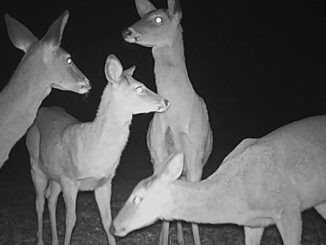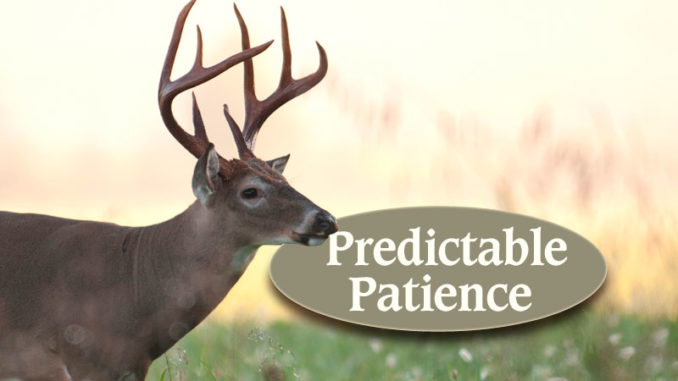
If the deer in your area are still rutting when the season closes, the worst thing in the world you can do is hunt too much too early. Here’s why you’re better off showing a little patience.
There is no doubt that the rut is the absolute best time to shoot the biggest buck your property is capable of attracting.
Like love-struck junior high boys who risk one tardy after another to walk their girls to class on the other side of campus, Louisiana’s bucks risk getting shot chasing does.
Take a nice buck I shot a few years ago at my place in Washington Parish: While it was hanging from a skinning rack, I noticed it looked vaguely familiar.
Browsing back through some deer-cam photos on a card I had pulled earlier that same day, I came across a buck that looked identical to the one I had just shot.
Closer examination revealed it was the same buck.
An even closer examination revealed the deer stood in front of this particular camera almost three miles down the road hardly 10 hours before it walked out in my food plot.
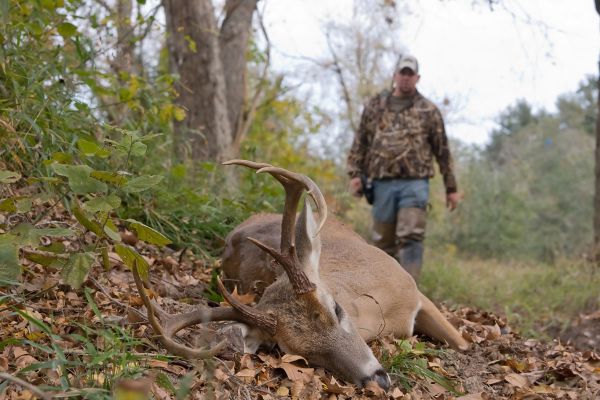 The risk this buck made to find a mate didn’t pay off for it.
The risk this buck made to find a mate didn’t pay off for it.
And when I think about how many deer stands this buck had to pass to get from point A to point B, it made me realize that hunting the rut isn’t a guarantee — but it does stack the odds in your favor.
Outdoor writers have written countless articles about how to hunt the rut. The biggest problem I have with most of them is that following their advice about waiting on the rut to hunt your best spots is a lot easier to follow when you don’t have to wait long for the rut to actually start.
I mean, I live in Washington Parish where several of my best sources of deer-hunting information have told me they have seen lots of bucks chasing does during the spring turkey season.
I’ve heard of folks seeing bucks halfheartedly chasing does during early December, but for this part of the state it’s been my experience that the rut really doesn’t kick into high gear until Christmas week at the earliest.
Since rifle season doesn’t begin until about the third week of November in Area 4, that’s a lot of time spent in a deer stand waiting for something to happen.
Some folks like Stephen Chatman with K&S Archery in Franklinton take off to hunt public land in Missouri while they’re waiting on the rut to kick in here.
However, those of us who don’t have that opportunity are faced with two options: sit in a stand and stink up your spot while hoping a deer walks by or wait four long weeks for things to get right.

And for those of us who chose to hunt while we’re waiting, I’ve noticed that sitting in a stand so long without seeing any bucks tends to burn you out before the rut even begins.
Then it becomes much easier to find reasons just to stay in bed.
“But that’s what you’ve got to do,” Franklinton deer hunter Bob Watson said. “About the only way to kill them before the rut kicks in is to try to hunt as close to their bedding areas as possible.
“Good luck with that because these bucks bed in stuff so thick you’ll never even know you’re standing by one unless you step right on top of him.”
That’s why Watson is content to sit on his porch and watch does browsing through a clearing on the other side of a field across from his house.
He watches their behavior, and when he sees immature bucks starting to bump these does around, he knows it’s time to trade in the comfort of his porch for the confines of a tree stand.
“It’ll pick up a little bit in December during that first little breeding phase,” Watson said, “but in Washington Parish, I don’t really start thinking hard about hunting the rut until after Christmas.
“When the season is winding down is when you want to be in the stand around here.”
Unlike the Midwest, where hunters can set up on a well-worn trail and wait on a buck to come by hot on the trail of a doe, in Area 4 — where the rut comes late — the best way to see a big buck through your scope is to have comfortable does.
When those does come into heat, you’ll surprisingly see bucks you never even knew were around; they do a good job staying hidden until that irresistible urge to find a doe hits them.
“If you’ve got a few does feeding every afternoon in your food plot, those bucks are eventually going to come out in the plot when any one of them come into heat,” Watson added. “But if you’ve been going in on your plot and hunting it every afternoon before the rut kicks off, you’re going to have some wary does that don’t want to come out until it gets dark.”
Michael Williams also hunts Washington Parish, and he noted that — like Watson — he has always killed his biggest bucks from the end of December through the end of January. He also claimed there’s no such thing as a post-rut period in Washington Parish.
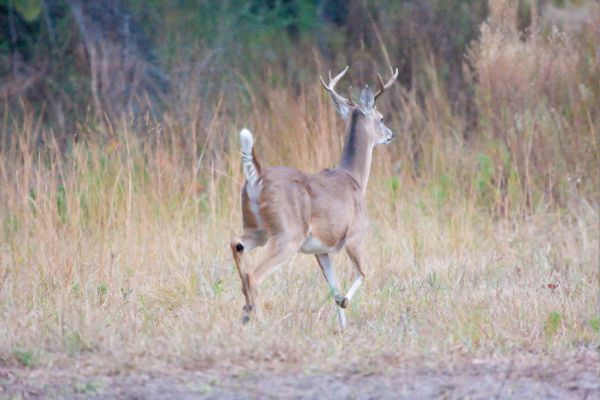
“They don’t get settled down and turn back to food sources because they’re still running does when the season ends,” said Williams who was one of the hunters who has seen bucks chasing does during turkey season.
When the rut does eventually kick off on Washington Parish, Williams said bucks will keep running does until they have bred every doe in the area. Once they finish breeding their local does, that’s when they leave their core areas and head out looking for other does to breed.
“That’s when we kill them,” he said. “This is when we’ll kill a buck that we’ve never seen before in person or on camera.
“They get out of their core area, and aren’t as familiar with their surroundings and don’t have the hunters patterned like they do back at home.”
Neither hunter is an advocate of totally abandoning food plots during the rut because if that’s where your does are feeding that’s where that buck that’s out of his territory is going to mess up and get killed.
Capt. Eric Dumas, more known for hammering big Lake Pontchartrain speckled trout than hunting rutting deer on the lake’s north shore, had a little advice for hunters hunting food sources during the rut.
“Let your does be,” Dumas advised. “Don’t mess with them at all. I let mine go and come as they please, because if I shoot them on a food source during the rut I’ve just taken out any reason a buck has to come to the same source.
“He’s just going to head on down the road to find some more does.”
Anybody who has ever hunted the rut knows the behavior does exhibit when there is a buck lurking nearby in the woods just on the edge of a plot — they continually look back over into the woods as if expecting something is there.
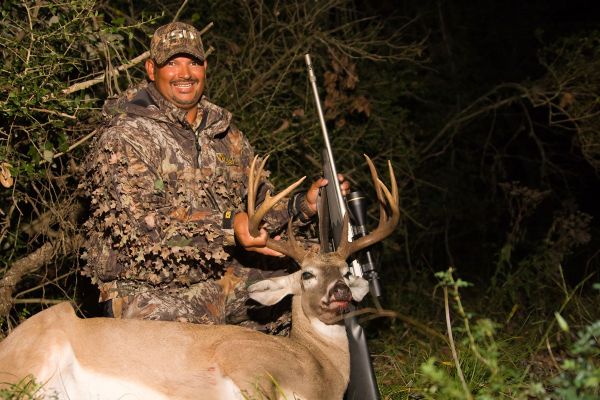
The only problem with this is that if all the doe’s doing is looking, that buck probably won’t make its appearance known in the plot until right at dark.
Now, if that doe is ready to be bred, she’s not going to be looking over her back too long because that buck is coming out no matter what to try to breed her.
“And once he finishes breeding that doe, he’s going to take off and look for another one,” Dumas said. “That’s why my No. 1 rule for hunting the rut is to not give up until it’s over or the season ends.”
In fact, Williams and some others around these parts believe St. Tammany and Washington parishes have so many does that the bucks run themselves to crazy trying to breed all of them.
“They run themselves to death one of two ways,” Williams said. “Either they’ll run so hard that they eventually mess up and get shot, or they run so hard that they’ll physically run themselves down.
“All that running and no eating might not kill them, but they can get pretty poor from the rigors of the rut.”
There’s no mistaking that the rut is the best time to kill a good buck, but waiting on the rut to start in Area 4 takes a lot of patience.
Something love-struck junior high boys and rutting bucks have very little of.
Try rotating deer stands on trail intersections
Washington Parish deer hunter Karl Casanova told me one time that he thinks the best two opportunities Area 4 deer hunters have for killing a good deer are early in the bow season or right at the end of the bow season.
“I think one of the keys to successfully hunting the rut is to have a few different stands that you don’t hunt very much,” Casanova said. “I’ve got a couple on the edges of some food plots, but most of my stands are either on trails to the plot or on trails that aren’t even associated with my plots.”
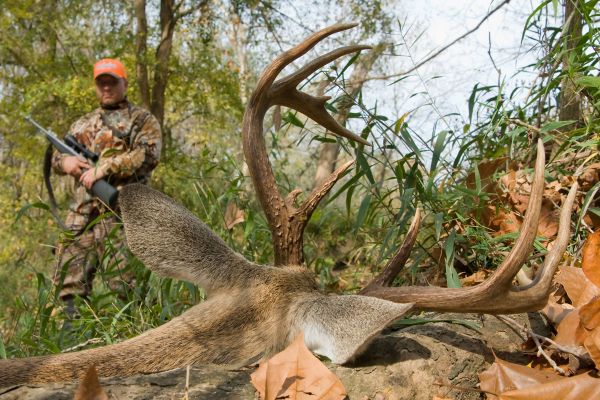 Knowing that bucks — even rutting bucks — don’t really want to come out on a plot until dark, Casanova tries to set up his stands as far back on those trails as he can to up his chances of spotting a big buck while it’s still light enough to shoot.
Knowing that bucks — even rutting bucks — don’t really want to come out on a plot until dark, Casanova tries to set up his stands as far back on those trails as he can to up his chances of spotting a big buck while it’s still light enough to shoot.
“I’ll walk those trails until they get really hard to see,” he said. “Then I look for secondary trails that lead into the main trail. Wherever I can find a few different trails all coming together at the same spot, that’s where I’ll set up my stand.”
Casanova also likes to look for deer droppings to help him know he’s around feeding does that are likely to attract rutting bucks.
“If you don’t have any droppings, the deer aren’t sticking around very long,” he said. “If I can find one of those trail intersections with some droppings, I know I’m on to something that could pay off during the rut.”
Define daytime deer-hunting locations
The great thing about writing about hunting and fishing is that I get to apply the same tips and techniques to my own hunting and fishing as Louisiana Sportsman readers do.
However, there are two tips I’ve shared over the years that have really made an impact on how I hunt my own property.
Bassmaster Elite Series pro angler Dennis Tietje said something so simple and understated during a deer-hunting interview one time that I could have easily dismissed it as not worth sharing in an article.
“To successfully hunt the rut,” he began, “you’ve got to hunt where your does are during the daytime.”
The advice didn’t seem all that pertinent at the time, considering we can’t hunt deer at night. But the more I thought about it the more truth I saw in Tietje’s advice.
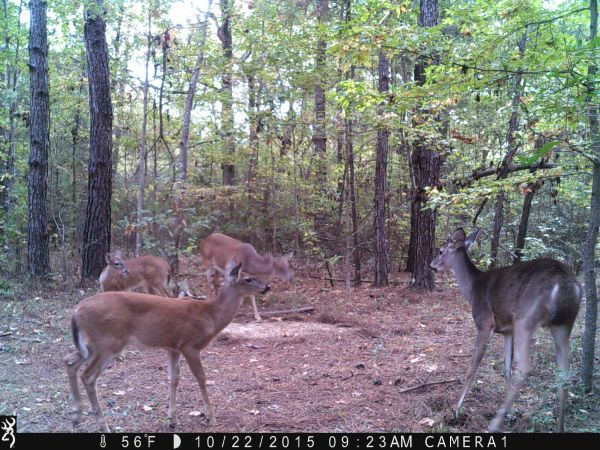 It got me started thinking about how I hunt my own property in Washington Parish, and I realized that the majority of pictures I had of deer were at nighttime.
It got me started thinking about how I hunt my own property in Washington Parish, and I realized that the majority of pictures I had of deer were at nighttime.
And these were the same places I had been hunting during the daylight.
The more I thought about Tietje’s advice, the more foolish I realized my own hunting habits were.
I started moving my cameras around my property until I started getting daylight pictures of deer. But it wasn’t simply a matter of moving them from one plot to another. Rather, I moved them from the edges of the plots to the woods surrounding them.
It was then that a whole new world of deer hunting possibilities surfaced.
I couldn’t believe I was getting pictures of deer all day long in the heart of a pine plantation just to the northeast of one of the plots that nobody hunts except for kids and out-of-town family and friends.
The more I investigated the pines the more deer sign I found that pointed to daytime deer activity. The place was full of rubs, scrapes, and deer trails — sign I just don’t see in or around my food plots.
That’s when I started hunting the woods surrounding food plots rather than hunting directly on top of them.
Strangely enough, my success rate skyrocketed when I started hunting the places on my property the deer were using during the day.


